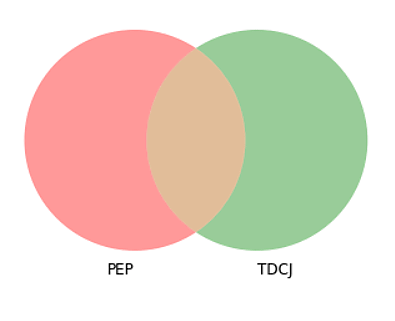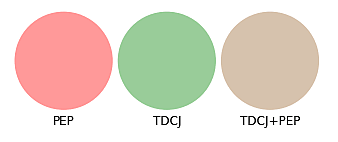
I’ve written a series of papers on illegal immigrant crime in Texas based on data from the Texas Department of Public Safety (DPS). My research was featured on the front page of The New York Times, in stories in The Washington Post, and in academic journals. In late 2022, the Center for Immigration Studies (CIS) published a report alleging my papers missed illegal immigrant criminals who were identified in prison by the Texas Department of Criminal Justice (TDCJ), resulting in an inaccurately low criminal conviction rate for illegal immigrants. After making numerous additional data requests from DPS, analyzing the data, and communicating with one of the authors of the CIS study, it’s now clear that illegal immigrants have a lower homicide conviction rate in Texas.
The homicide conviction rate for illegal immigrants was 2.4 per 100,000 illegal immigrants in 2015, which is lower than the homicide conviction rate of 2.8 per 100,000 for native‐born Americans. Legal immigrants still have the lowest homicide conviction rate at 1.1 per 100,000 legal immigrants. Those rates are similar across the years for which data are available.
Setting the statistical record straight on illegal immigration and homicide is important, but it is not the whole story. It can’t be when it comes to homicide or any serious crime. The recent arrest of Jose Antonio Ibarra for the murder of Laken Riley, a student at the University of Georgia, is a brutal reminder that statistics can only inform generally. They can’t tell us much about individual cases. Ibarra crossed the border illegally and was granted parole.
Few people are murderers, and illegal immigrants are statistically less likely to be murderers. Still, some illegal immigrants do commit homicide, and that statistical fact is no comfort to victims and their families. More importantly, nobody should expect the statistics to comfort individuals affected by violent crime. Murderers should be arrested, tried, convicted, and punished to the fullest extent of the law, regardless of their immigration status. At the same time, we should understand that more enforcement of immigration laws will not reduce homicide rates.
Backstory
This section is the backstory of the debate over illegal immigrant crime statistics in Texas. You can skip to the next section for the results and how CIS mistakenly overcounted the number of illegal immigrant murderers. In 2017, I discovered that the DPS website included fascinating data on illegal immigrant criminals that was seemingly unavailable anywhere else. It was clear that all immigrants had a lower incarceration rate than native‐born Americans, but no data source ever separated legal immigrants from illegal immigrants. Thus, illegal immigrants could have a higher crime rate than native‐born Americans because there were so many more legal immigrants with a much lower crime rate. Ann Coulter rightly complained about the problems with immigrant crime data:
I would prefer to have the actual numbers of legal and illegal aliens arrested and convicted of crimes.… Unfortunately, the government won’t tell us how many immigrants commit crimes–much less what their crimes were.… The most extensive information on criminal aliens collected by the federal government is a bare‐minimum estimate of the number of immigrants in American prisons and jails.
Tipped off by the DPS website, I sent public information requests (PIRs) to every state. Texas alone kept data on the immigration statuses of people convicted and arrested for specific crimes. The immigration information of arrestees was recorded when Texas police ran the arrestee’s biometric and biographical information against information in the Secure Communities program (SCOMM), then the Priority Enforcement Program (PEP) after Obama canceled SCOMM, and then SCOMM again when Trump reactivated it. All states had similar data, but only Texas DPS kept them and other state law enforcement agencies did not (all states should keep these data).
I made several requests to DPS for the data, which consistently showed that illegal immigrants had lower criminal conviction and arrest rates than native‐born Americans. My first paper on illegal immigrant crime in Texas and several other papers changed the tenor of the debate over illegal immigration and crime.
Even Mark Krikorian, the executive director of the Center for Immigration Studies (CIS), a restrictionist think‐tank, said, “A lot of data does suggest immigrants are less likely to be involved in crime.” My research even inspired academics to get into the game.
In late 2022, the Center for Immigration Studies (CIS) published a report alleging a significant error in my papers: I had supposedly missed illegal immigrant criminals who were identified in prison by the Texas Department of Criminal Justice (TDCJ), resulting in an undercount of illegal immigrant criminals. CIS said it had received better data from Texas DPS that confirmed illegal immigrants had a higher criminal conviction rate than legal immigrants and others in the state. Sean Kennedy, one of the authors of that report, appeared on Tucker Carlson’s Fox News show to discuss his research and to criticize my work—which is the second time Carlson had on a guest to specifically criticize me without inviting me on to defend myself.
CIS made three good points in their criticism. First, I should have requested additional data on TDCJ‐identified illegal immigrants. I was aware of other checks of illegal immigrants in prison, which I accounted for using data on DPS’ website, but I did not request that data from DPS directly. That was my mistake. Second, researchers looking at the DPS data should ignore total criminal convictions and other crimes to focus on homicide data because government checks of convicted murderers are more thorough and will identify more illegal immigrants after conviction. The TDCJ focuses on examining the background of criminals convicted of serious crimes who are incarcerated for long sentences. Third, TDCJ requires time to investigate the backgrounds of criminals in prison, and DPS also needs time to update its data based on TDCJ findings. As a result, researchers should wait several years to analyze past data. In all, those are three points from CIS that I accept.
CIS made a fourth point that is unconvincing. They argued that DPS does not specifically identify native‐born Americans, so it was inappropriate for me to subtract illegal and legal immigrant homicide convictions from the total number of homicide convictions to arrive at the number of homicides committed by native‐born Americans. While that is administratively true, subtracting legal and illegal immigrant crimes from the total number of crimes is a methodologically sound way to estimate the number of crimes committed by native‐born Americans—especially after several years have passed and DPS adjusted their data based on TDCJ identifications of illegal immigrant convicts. Subtraction is a valuable mathematical operation here. As a result of CIS’ good points, this blog post will focus on homicide convictions in Texas in 2015.
CIS identified 54 illegal immigrant individuals convicted of homicide in 2015, 46 by PEP and 8 in prison by TDCJ. That was substantially higher than the 46 that I identified through only PEP. That difference of 8 was enough to increase the illegal immigrant conviction rate for homicide above that of native‐born Americans. I wrote a weak response to CIS that nibbled around the edges of their critique and cobbled together data from other sources but did not refute their central points. The internet rightly pounced on my weak response.
Illegal Immigrant Homicide Conviction Rates in Texas 2015
CIS’s criticisms prompted me to make many more data requests from DPS, which also included requesting email communications between DPS and the authors of the CIS report to help replicate their data requests exactly and confirm that the variables in the data requests were clearly defined.
Here are the results:
- I initially mistakenly did not ask for TDCJ‐identified illegal and legal immigrants.
- CIS made a worse mistake by double counting some illegal immigrants convicted of homicide.
- Once all the numbers are correctly accounted for, my original research slightly overstated the number of illegal immigrants convicted of homicide. My original research included many illegal immigrants who were already identified by TDCJ.
- My original point that illegal immigrants have a lower homicide rate than native‐born Americans in Texas is correct.
Here’s how CIS unintentionally double‐counted some homicide convictions. To be clear, the authors of the CIS report did not manipulate the Texas homicide numbers or intentionally engage in statistical malpractice. They neglected set theory, did not heed DPS warnings about potential double‐counting, and did not ask for more detailed data.
In 2023, I made a data request from DPS based on two hunches. The first was that if TDCJ identified illegal immigrants missed by PEP, then TDCJ also likely identified legal immigrants or native‐born Americans who were misidentified as illegal immigrants by PEP. This could be significant as the number of murderers here is so small that a few misidentified individuals could significantly change relative conviction rates.
The second hunch was that CIS’ data double‐counted some illegal immigrant criminals. For instance, some illegal immigrants identified by TDCJ or PEP may have also been identified by PEP or TDCJ, respectively. In other words, some illegal immigrants convicted of homicide may have been counted more than once. Thus, I requested DPS data for illegal and legal immigrants who were: 1). Only identified by PEP and not by TDCJ, 2) Only identified by TDCJ and not by PEP, and 3) Only identified by both PEP and TDCJ and who were not identified through PEP alone or TDCJ alone. Those are three distinct data buckets and there should be no double‐counting when the data are organized thusly.
DPS gave me data that seemed to confirm that CIS’ data double‐counted some illegal immigrants convicted of homicide. For homicide convictions in 2015, DPS reported to me that PEP alone identified 5 illegal immigrants, TDCJ alone identified 8, and PEP and TDCJ together identified 30 illegal immigrants. These three distinct data buckets added up to a total of 43 illegal immigrants convicted of homicide who were arrested in 2015. Additionally, there were two legal immigrants identified by TDCJ who were likely initially counted as illegal immigrants by PEP.
If you’re keeping track, my original report found 46 illegal immigrants convicted of homicide in 2015 and CIS found 54 convicted in that year. The actual number is 43 without double-counting—three less than my original 46 and 11 less than what CIS found. I can’t discover exactly why the newest data show three fewer homicide convictions than I originally found, but the two convicts initially identified as illegal immigrants who were actually legal immigrants get us two‐thirds of the way there. The Texas DPS datasets are updated frequently; they are not frozen, so another illegal immigrant convict was subtracted at some point.
Another possibility is that my recent data requests focused on the year of the initial arrest, while CIS’ data were for the year of conviction. That could explain the missing person who was arrested in another year. The year of arrest versus year of conviction difference can explain a handful of homicide convictions being counted in different years, but that difference can’t affect the overall finding of relative conviction rates over time because an addition to one year is a subtraction from another.
The data that DPS gave CIS were organized into categories that double‐counted some individuals, leading to a higher number of illegal immigrant homicide convictions. Figure 1 attempts to visualize what happened to CIS’ data. Their data on illegal immigrant homicides were the sum of the entire green circle, the entire red circle, and the brown area added again to the red and green circles. That resulted in some double counting. CIS counted 8 individuals who were convicted of homicide and identified by TDCJ, but they erroneously added those 8 TDCJ homicide convictions to the total number of 46 illegal immigrants identified by PEP.
Figure 1
Center for Immigration Studies Data Request from Texas Department of Homeland Security

Figure 2 shows the data buckets for the data I requested from DPS. The three buckets are 1) Illegal immigrants who were identified by PEP and not by TDCJ, 2) Illegal immigrants who were only identified by TDCJ and not by PEP, and 3) Illegal immigrants identified only by both PEP and TDCJ and who were not identified through PEP alone or TDCJ alone. Cato’s data request avoids the overcounting problem that CIS encountered.[i]
Figure 2
Cato Data Request from Texas Department of Homeland Security

Texas DPS warned Sean Kennedy, coauthor of the CIS report, about this potential problem of double counting in an email on June 7, 2022. Kennedy asked for PEP counts, TDCJ counts, and cumulative counts of illegal immigrant criminals. This was DPS’ response:
“We are unable to break down the data as you described specifically in your example. We can supply the number uniquely identified by TDCJ (Prison category) and the total number of Illegals identified through PEP (this can include illegals also identified by TDCJ). Please note, if someone was uniquely identified through TDCJ, but at a later time is identified through PEP, the individual would no longer be in the Prison category and would reflect the PEP identification [emphasis added].”
According to DPS, some of the illegal immigrant murderers whom TDCJ and PEP identified were counted more than once, leading to an erroneously high number of illegal immigrant murderers, but those only identified through TDCJ were not double counted. But if someone was earlier identified by PEP and later identified through TDCJ, they weren’t necessarily subtracted in PEP. As a result, my later Cato request for data on illegal immigrant criminals identified by PEP alone, TDCJ alone, and by both PEP and TDCJ but neither separately, clears up this data issue. According to the data definitions DPS gave me, those three separate data categories are distinct and do not overlap.
Removing the instances of double‐counted illegal immigrant murderers lowered their homicide conviction rate to 2.4 per 100,000 illegal immigrants in 2015, which is lower than the homicide conviction rate of 2.8 per 100,000 for implied native‐born Americans (Figure 3). The homicide conviction rate for native‐born Americans is calculated by subtracting the number of legal and illegal immigrant individuals convicted of homicide from the total number of all individuals convicted of homicide.
Legal immigrants still have the lowest homicide conviction rate at 1.1 per 100,000 legal immigrants. The illegal immigrant homicide conviction rate is 15 percent below the native‐born rate, which is closer than in my earlier research.
Conclusion
A series of hunches prompted me to make more specific data requests from DPS, whereby I discovered that CIS had overcounted illegal immigrant murderers. DPS warned CIS about potential overcounting. However, I cannot blame CIS for counting some illegal immigrants twice. The data released by DPS is difficult to understand, and I had to make multiple requests in 2023 and 2024 to guarantee that the variables were properly defined. Ultimately, DPS needs to release more carefully identified and defined data so researchers, policymakers, and the public can better understand illegal immigrant criminality. More importantly, the evidence is clear:
- Illegal immigrants have a lower homicide conviction rate than native‐born Americans in Texas.
- Legal immigrants have a lower homicide conviction rate than native‐born Americans and illegal immigrants in Texas.
- The lower homicide conviction rate for illegal immigrants is evidence that they have a lower overall criminal conviction rate.
It’s also important to remember that statistics like these can’t inform individual cases, nor should we expect them to comfort people affected by crimes committed by individuals who are members of groups statistically less likely to be violent or property criminals. If Ibarra murdered Laken Riley, then he should be punished to the maximum that the law allows. Still, the statistics do tell us that deporting all illegal immigrants, ending parole, curtailing asylum, or any combination of those policies would not reduce homicide rates.
[i] In set theory notation, CIS’ data can be expressed as: (P∪T)+(P∩T) where P is PEP and T is TDCJ. Thus, the CIS data overcounted the number of illegal immigrant criminals convicted of homicide by summing the two sets and the intersection (overlap) of the two sets. Cato’s data is properly expressed in set theory notation as: P∪T. P∪T is the union of two mutually exclusive sets with no overlap.





























